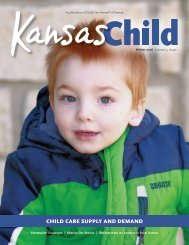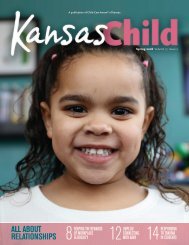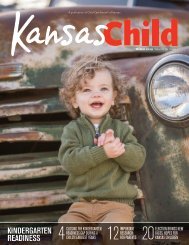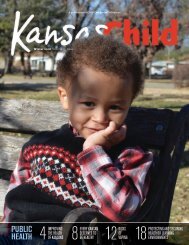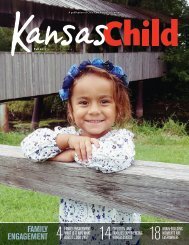2019 Winter Kansas Child
Create successful ePaper yourself
Turn your PDF publications into a flip-book with our unique Google optimized e-Paper software.
FAMILIES AS COMMUNICATORS:
Early childhood providers and families have effective
and ongoing communication.
• Programs and families consistently initiate
communication and share knowledge that is
timely and facilitated through multiple methods.
• Practices, supports and resources are responsive
to the cultural, ethnic, racial, language and socioeconomic
characteristics and preference of families and their communities.
What does it look like in practice?
• Families, educators, practitioners and the community engage in
consistent, two-way communication.
– Establish multiple modes of communication to share information.
– Ensure communication between families, educators, practitioners
and the community is continuous and fluid.
– Engage parents in conversations where child assessment data are
shared, and parents learn about children’s progress.
• Families are able to comfortably and confidently communicate with
educators, practitioners and the community.
– Introduce families to those who will be working with the family
and child.
– Provide families with interpreters for effective communication.
– Make written documents available in multiple languages.
– Communicate with families and their children in the context of their
language, culture and traditions.
• Families have a shared understanding of desired program outcomes.
– Have procedures in place to communicate with all families.
– Provide orientation to the program for families.
– Encourage family participation by including an open-door policy,
family volunteers, and participation opportunities.
– Integrate families’ traditions and culture into instructional
practices, events and activities.
FAMILIES AS ADVOCATES:
Families actively engage as an advocate and
decision-maker for their child.
• Families have opportunities that promote informed
options and decision-making.
• Programs and communities engage families by
providing opportunities to be involved in program
leadership and decision-making.
• Programs and communities empower families to be advocates.
• Families are aware of resources for selecting and accessing needed
services.
What does it look like in practice?
• Families have access to community supports and resources.
– Utilize a needs assessment to determine supports and resources
that will benefit families.
– Connect families with relevant supports and resources.
– Support families in navigating services.
• Families are supported by community collaborations.
– Provide networks of support.
– Facilitate referrals to additional health or educational services.
– Identify and address gaps in services and unmet needs in the
community.
• Families are involved within the community based on their interests
and goals.
– Create safe and respectful communities that foster engagement
and participation.
– Encourage families to participate in volunteer opportunities and
community service projects based on their interests and goals.
FAMILIES AS PARTNERS:
Successful partnerships exist between
families and professionals based upon mutual
trust and respect.
• Early childhood professionals use child and
family strengths as a basis for engaging
families.
• Families promote learning for their children.
What does it look like in practice?
• Families have strong partnerships and trusting relationships among
educators, practitioners and the community.
– Initiate relationships with families that are receptive, responsive
and respectful.
– Offer formal and informal opportunities for families to build an
agreed-upon and collaborative relationship.
• Families, educators, practitioners and the community are equal
partners in decision-making that affects children and families.
– Involve families through the use of feedback tools to inform
procedures and strategic planning.
– Include families in the creation of policies, practices and programs.
FAMILIES AS COMMUNITY
MEMBERS:
Families are active participants in their communities
and connect to resources and services.
• Comprehensive services are available,
affordable and accessible.
• Communities provide broad supports for families.
• Families live in safe and stable environments.
What does it look like in practice?
• Families have access to community supports and resources.
– Utilize a needs assessment to determine supports and resources
that will benefit families.
– Connect families with relevant supports and resources.
– Support families in navigating services.
• Families are supported by community collaborations.
– Provide networks of support.
– Facilitate referrals to needed additional health or educational
services.
– Identify and address gaps in services and unmet needs in the
community.
• Families are involved within the community based on their interests
and goals.
– Create safe and respectful communities that foster engagement
and participation.
– Encourage families to participate in volunteer opportunities and
community service projects based on their interests and goals.
KANSAS
Family Engagement and Partnership
Standards for Early Childhood
In the fall of 2019 a resource was
created and can be accessed online
at http://bit.ly/388pjrW.
Printed copies may be ordered by
calling the Kansas Parent Information
Resource Center at 1-866-711-6711.
6
A Publication of Child Care Aware ® of Kansas











